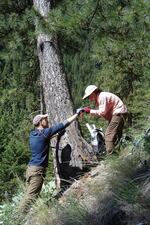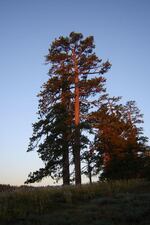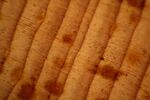
Erika Wise and Matt Dannenberg look at a newly sampled tree core in the Okanogan National Forest.
Troy Knight
Turns out tree rings can do more than just tell you how old a tree is. Researchers have found they can also help track Pacific storms over centuries. That could help out water managers and climate modelers.
To get that data, first Erika Wise had to collect core samples of more than 200 ponderosa pines in Washington’s Columbia Basin.
“Some of the ponderosa pine trees date back to the 1400s,” Wise said. “They’re incredibly old trees, and they’re on these ridges with this view of Yakima down below.”
Wise is an associate professor of geography at the University of North Carolina at Chapel Hill and the lead author of the report. It was published in Science Advances.

An ancient Ponderosa pine at sunrise. Researcher Erika Wise said some of the ponderosa pine trees dated back to the 1400s.
Erika Wise
She and her colleagues turned to ponderosa pine trees in part because the red-barked trees are sensitive to moisture — and their age and location were ideal for their study of changing storm patterns. The researchers were able to show how storm tracks have changed over hundreds of years, all by looking at the variation in tree rings.
They found storms have gotten stronger overtime. They’ve also increased in frequency, which is in part due to natural weather cycles that have been amplified by climate change.
That’s important information for water managers. Take the recent drought.
“Who gets water and how much they get is really dependent on where these storms go,” she said. “(It) really determines whether that snow or rain comes.”
Wise said other research she’s done shows storm tracks are also associated with things like the number of wildfires in a season or when plants start to grow.

Researchers used ponderosa pine tree core samples to help track Pacific storms over centuries. This is the view of a sanded core under the microscope showing a marker year.
Erika Wise
Next, Wise wants to use tree rings to look at storms in different seasons, which is expected to shift with climate change.
She said this research provides an important baseline for storm strength and frequency. A lot of instrumental data dates back 100 years; storm track data goes back about 50 years.
This new study extends that data back hundreds of years — especially important in the face of budget cuts and as researchers are predicting what could happen in the future.
“We really need that monitoring data because we can’t detect changes unless we have that underlying data,” Wise said.
